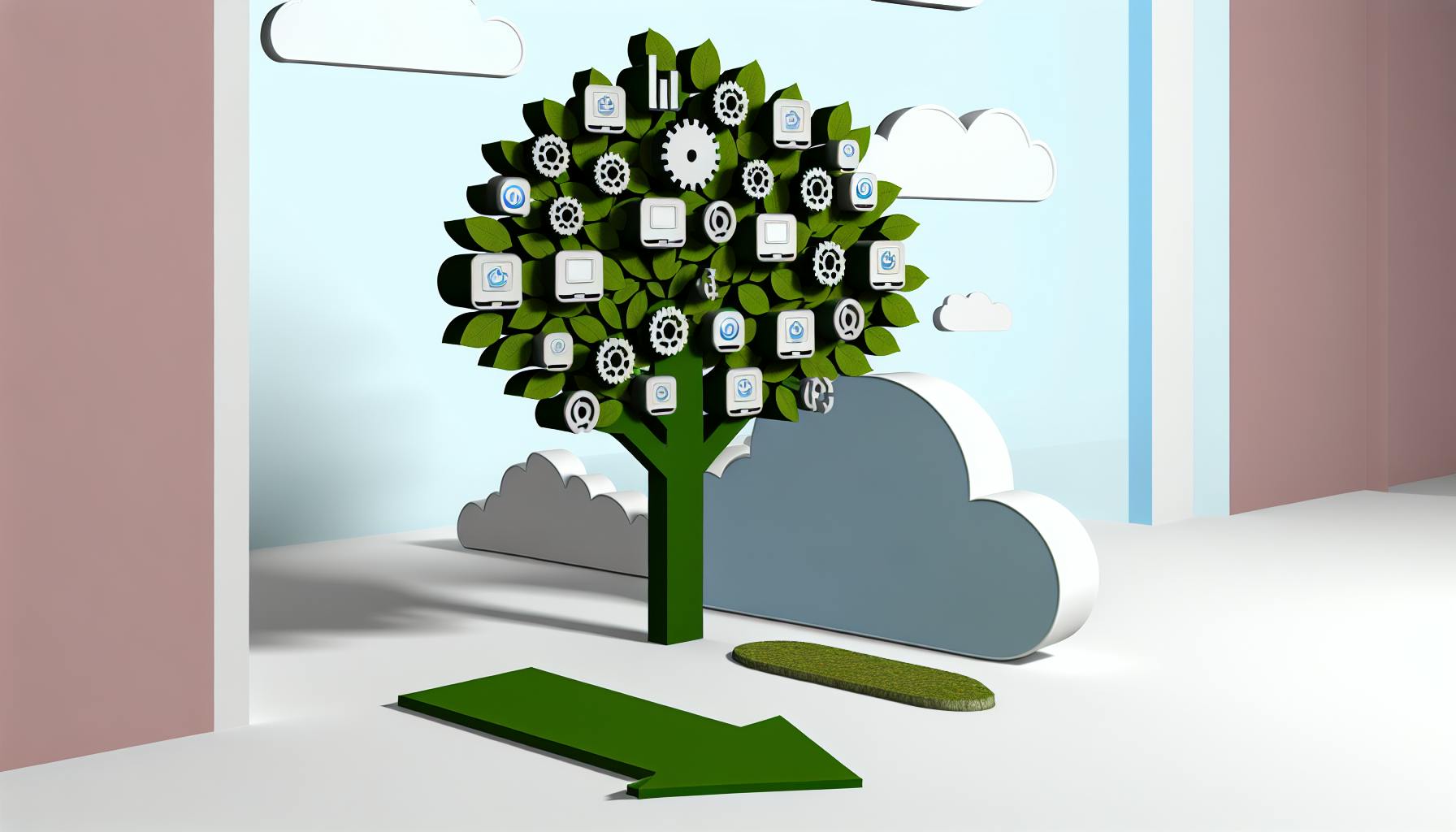Developing a green business strategy is crucial for SMEs aiming to reduce their environmental impact and embrace sustainable operations.
This comprehensive guide outlines the key steps enterprises can take to implement an effective green strategy that drives growth while benefiting the planet.
You'll discover practical measures to assess your footprint, set achievable sustainability goals, execute green ideas across operations, leverage certifications for credibility, and more.
Embracing a Green Business Strategy for Future Success
Small and medium enterprises (SMEs) face increasing pressure from stakeholders to implement sustainable practices. This introduction offers a comprehensive overview of the steps necessary to develop a robust green business strategy.
What is Green Business? Defining the Landscape
A green business prioritizes environmental sustainability across its operations. This involves minimizing ecological impact by reducing energy usage, carbon emissions, waste, and natural resource consumption. Key concepts include:
- Sustainability: Meeting current needs without compromising future generations' ability to meet their own needs.
- Circular economy: Designing products and processes to eliminate waste through reuse, repair, refurbishment, and recycling.
- Carbon footprint: Total greenhouse gas emissions caused directly or indirectly by an organization.
The Business Case for Going Green
Adopting a green business strategy delivers tangible benefits:
- Cost savings from energy efficiency and waste reduction initiatives.
- Increased sales and market share by meeting rising customer demand for sustainable products.
- Improved public image and reputation by communicating sustainability commitments to stakeholders.
- Failure to act also presents financial and reputational risks.
Assessing Your Environmental Footprint: The First Step
Key steps to understand current sustainability performance:
- Measure carbon footprint with emissions accounting tools.
- Conduct audits tracing resource flows and waste streams.
- Survey employees to gauge environmental awareness and ideas.
- Benchmark against sustainability leaders in your industry.
This environmental baseline identifies priority areas for green initiatives.
Setting Achievable and Impactful Sustainability Goals
Well-defined targets drive strategy success. Best practices:
- Set specific, time-bound goals, e.g. "50% emissions reduction by 2025".
- Ensure executive leadership buy-in and assign responsibility.
- Regularly track progress through key performance indicators.
- Communicate achievements transparently to stakeholders.
Executing Green Business Ideas for Operational Excellence
Practical initiatives with quick wins:
Energy
- Switch to renewable energy sources.
- Upgrade to energy-efficient equipment.
- Enable remote work options.
Supply chain
- Source sustainable materials.
- Favor low-impact transportation.
Small changes add up to make businesses greener, more resilient, and future-ready. The journey of a thousand miles begins with a single step – take yours today!
What are the 5 elements of green business model?
According to systems theory, there are 5 key elements for building a sustainable green business model:
-
Diversity
- Having a diverse range of products, services, processes or business units creates flexibility and resilience. This protects the business from market fluctuations or supply chain issues.
-
Modularity
- Separate components that can be recombined mean the business can adapt faster. Modules make iterating products, operations and partnerships simpler.
-
Openness
- Collaborating with stakeholders and integrating their feedback leads to better solutions. An open business also benefits from shared knowledge.
-
Slack resources
- Having spare assets or capabilities helps deal with unexpected events. This buffers the business from small failures or external shifts.
-
Matching cycles
- Aligning the pace of production, consumption and renewal ensures sustainability. Managing resource flows this way maintains business viability.
Adopting these systemic design principles allows small businesses to build responsible and regenerative models optimized for the green economy. What practices could you integrate into your operations?
What is green marketing strategy?
Green marketing strategy refers to the process of promoting environmentally friendly products and services through marketing tactics and initiatives. This involves making sustainability a core part of a company's brand identity and business operations.
The goal of a green marketing strategy is to show customers that your company cares about the environment while also providing quality products. This can help attract eco-conscious consumers and improve brand loyalty.
Some common elements of a green business strategy include:
- Sustainable product design - Making products out of recycled, renewable, or other eco-friendly materials
- Responsible packaging - Using minimal, recyclable or biodegradable product packaging
- Carbon footprint labeling - Displaying product carbon footprints on packaging or your website
- Eco-friendly messaging - Using sustainability-focused language and messaging in your promotions
- Social responsibility - Donating to environmental causes or offsetting business carbon emissions
Following green principles can be a strategic advantage as more consumers factor sustainability into their purchase decisions. With some planning, even small businesses can integrate elements of a green marketing plan to strengthen their brand.
What is an example of a green business model?
A green business model typically incorporates sustainability into its core strategy and operations. For example, outdoor apparel brand Patagonia makes durable and reusable products while championing environmental causes. Businesses producing reusable bottles like Klean Kanteen are reducing single-use plastic waste.
Examples of green business models include:
- Companies installing solar panels or other renewable energy infrastructure to power operations
- Eco-friendly cleaning product companies like Seventh Generation
- Local recycling businesses enabling community reuse and waste reduction
- Architecture firms designing energy-efficient buildings
- B Corps certified for high sustainability standards
The key is integrating environmental stewardship into a company's purpose, processes, and profits. Small changes like responsible sourcing, equipment upgrades for efficiency, and internal engagement programs make sustainability part of everyday business. With careful planning and commitment, SMEs can adopt business models that benefit both the environment and bottom line.
sbb-itb-919600f
What is a green business plan?
A green business plan outlines strategies to integrate environmental sustainability into a company's operations and processes. This involves assessing environmental impact across the business, setting green objectives, and implementing eco-friendly changes.
Key elements of a green business plan include:
- Defining sustainability goals - Set specific, measurable targets to reduce energy, waste, emissions, and resource consumption over 1, 3 and 5 year periods. Goals might include lowering carbon emissions 30% by 2025 or diverting 80% of waste from landfills by 2030.
- Conducting an environmental audit - Gather data on current energy usage, waste generation, procurement policies etc. This establishes a sustainability baseline to measure progress.
- Identifying opportunities - Pinpoint areas to implement green initiatives e.g. renewable energy, green transportation, sustainable supply chain etc. Prioritize quick wins and long-term systemic changes.
- Implementation roadmap - Create a step-by-step plan with targets and timelines to roll out environmental projects across facilities, operations and corporate policies.
- Budget allocation - Secure appropriate financial resources and incentives to execute the strategy e.g grants, internal funds reallocation, green loans and investments etc.
- Performance tracking - Continuously monitor key eco metrics to ensure initiatives achieve intended sustainability targets and outcomes.
An effective green business plan empowers a company to strategically transition towards an environmentally responsible business model.
Implementing the Best Green Business Strategy: A Roadmap for SMEs
This section delves into the various avenues for SMEs to reduce their environmental impact, showcasing green business examples and outlining actionable steps.
Energy Efficiency: The Heart of Sustainable Operations
Reducing energy consumption should be at the core of any green business strategy. Basic steps like replacing old light bulbs with LEDs, maintaining heating and cooling systems, and installing smart thermostats can significantly cut electricity usage. Going further, SMEs can conduct an energy audit to identify major energy drains, then upgrade equipment that has poor efficiency ratings.
Another simple yet impactful tactic is encouraging employees to switch off lights and devices when not in use. Other no-cost efforts like opening blinds to maximize daylight can also make a surprising difference. Leading by example, executives should visibly model sustainable behaviors.
Over time, the aggregate impact of minor tweaks and conscientious habits pays dividends on monthly utility bills while shrinking the company's carbon footprint. For more ideas, browse examples like TerraCycle's energy conservation efforts.
Building a Sustainable Supply Chain: Green Business Examples in Procurement
From sourcing raw materials to delivering end products, supply chains account for the bulk of emissions for many SMEs. Wise green business strategy should promote sustainability across the entire value chain.
When selecting suppliers, include environmental criteria alongside cost and quality considerations. Favor vendors with eco-friendly practices for energy, waste management, packaging, and transportation. Ask for reports on emissions and resource usage.
If existing partners lack green supply chain programs, provide incentives and support to improve their sustainability. Highlight your company's green vision and expectations. With pragmatic guidance, suppliers often warm up to the idea of win-win ecological partnerships.
Waste Reduction and Recycling: From Sustainability Strategy to Practice
Waste disposal carries heavy environmental burdens and costs. An easy starting point is switching to reusable goods and digitizing paper trails. Then focus on recycling all possible materials, educating staff on proper sorting and storage.
More advanced waste management entails scrutinizing procurement and manufacturing to minimize excess material usage. Can package sizes or product shapes be optimized to leave less leftover scraps? Such source reduction stops waste before it starts, aligning perfectly with green business strategy.
Conserving Water Resources in Your Green Business Strategy
While less prominent than energy, water connects to most business activities. Do bathrooms, kitchens, and cleaning operations use water efficiently? Regularly check for leakages, which can bleed thousands of gallons annually. Swap out inefficient toilets, faucets, showerheads, and other fixtures for WaterSense-certified models.
Evaluate if better sensors, valves, nozzles or closed-loop recycling systems could reduce water consumption during product development, manufacturing, or facility maintenance processes. Especially for water-intensive sectors like agriculture, bold conservation tactics directly buoy the bottom line.
Green Building Practices: Creating Sustainable Spaces
For SMEs owning business real estate, integrating green architecture elements demonstrates long-ranging ecological commitments while benefiting occupant health and productivity. Sustainable construction entails mindful material selection, smart space utilization, and energy-efficient building systems.
Whether planning new properties or retrofitting existing structures, take advantage of natural lighting, passive temperature regulation, rooftop solar panels, low-flow plumbing, non-toxic paints and finishes, and other planet-friendly touches. These robust but attainable tactics epitomize values-driven green business strategy.
Innovative Sustainable Business Models & Technologies
Switching to an environmentally-conscious business model is key for companies aiming to implement a robust green business strategy. Leveraging modern technologies and adopting innovative approaches to commerce can provide a springboard for impactful sustainability initiatives.
Circular Economy: A Green Business Strategy Example of Waste Elimination
The circular economy offers a prime example of how companies can eliminate waste through superior design, maintenance, reuse, and remanufacturing. Instead of the traditional linear model of "take, make, use, dispose", circular systems keep resources in circulation for as long as possible.
EcoHedge customer ABC Furniture Company switched to a leasing model for its office furniture range. By retaining ownership, ABC can ensure items are collected, reconditioned, and leased again, reducing waste and extracting maximum value from materials.
Embracing Sharing Platforms for Asset Utilization
Underutilized assets are common across many enterprises. Adopting sharing business models enabled through digital platforms can optimize asset usage rates.
Carsharing platform Wheels When You Want allows GreenDrive Rentals to rent out vehicles during downtime. This provides Greendrive with added revenue while increasing transportation access for the local community.
Sustainability Management Software: Your Digital Ally
Platforms like EcoHedge allow companies to seamlessly collect environmental data from various sources and departments. Centralizing this information establishes a single source of truth, optimizing reporting and unlocking detailed insights.
The software tracks emissions as per GHG Protocol standards, facilitating compliance. Customizable assessments and targets help continually improve performance over time.
💡 "EcoHedge has given us the tools to quantify and manage our footprint with simplicity we didn't think was possible" - Jane, Sustainability Manager at CPG Group
Green Financing: Funding Your Sustainable Business Strategy
Seeking green financing can provide the capital needed to turn ambitious sustainability plans into reality. Specialized loans, grants, incentives, and investment funds are available to support environmental projects.
The Green Business Loan Fund offers SMEs like gardening store The Urban Farm discounted lending for initiatives aimed at lowering emissions. This allowed Urban Farm to invest in renewable energy infrastructure, electric delivery vehicles, and eco-conscious inventory.
Innovating for the Environment: Green Product and Service Development
Developing inventive green offerings aligns perfectly with a wider sustainable business strategy. Leveraging approaches like green chemistry and biomimicry can lead to groundbreaking eco-friendly products and services.
EcoHedge customer BioEngineers Inc. designed a biodegradable packaging material that mimics the properties of a butterfly wing structure. This innovative solution met customer requirements while eliminating waste.
Embracing inventive technologies and business models unlocks immense potential for companies on their sustainability journey. Software like EcoHedge makes measuring and optimizing environmental performance simple, providing a solid foundation.
Green Marketing and Stakeholder Engagement
Exploring how SMEs can communicate their sustainability efforts effectively to build trust, enhance brand value, and promote green business strategy.
Utilizing Sustainability Reporting Frameworks for Transparency
Key sustainability reporting frameworks like the Global Reporting Initiative (GRI) provide comprehensive standards and metrics for companies to benchmark and disclose their environmental impact data. By utilizing globally-recognized frameworks, SMEs demonstrate a commitment to transparency and building trust with stakeholders.
Some best practices when leveraging reporting frameworks:
- Conduct a materiality assessment to identify your company's most significant environmental impacts. This allows you to focus reporting on the sustainability issues that matter most.
- Start small by reporting a few key emissions metrics the first year. Add additional metrics and data over time as tracking and reporting capabilities improve.
- Automate data collection and analysis as much as possible with carbon accounting software. This improves accuracy and frees up resources for strategic engagement with stakeholders.
Transparency creates accountability and rewards companies wiling to share their sustainability journey - an essential pillar of any green business strategy.
Leveraging Certifications and Ecolabels for Credibility
Independent sustainability certifications and ecolabels validate SMEs' environmental and social commitments with a recognized stamp of approval. Prominent labels like B Corp Certification, CarbonNeutral, and Fair Trade require rigorous assessment across key impact areas and performance thresholds.
Highlights for leveraging labels effectively:
- B Corp Certification - Validates company's entire social/environmental performance. Signals SME follows sustainable best practices.
- CarbonNeutral - Offsets all operational emissions to achieve net-zero footprint. Shows climate leadership.
- Fair Trade - Ensures fair pay and treatment for supply chain partners and producers. Builds ethical value chain.
These respected marks boost reputation and give assurance to all stakeholders company takes sustainability promises seriously.
Fostering an Environment of Employee Engagement and Ownership
Gaining internal buy-in across the organization amplifies impact of sustainability initiatives. Best ways to activate employees include:
- Foster bottom-up participation through Green Teams that crowdsource ideas and co-create programs tailored to employees' passions.
- Incentivize innovation through competitions to solve eco-challenges. Reward winners with bonuses or extra time off.
- Encourage friendly rivalry between departments over recycling rates, energy conservation, etc. Use leaderboards and celebrate wins.
- Provide training on sustainability issues and how employee actions contribute to green business strategy goals.
Empowered, motivated staff will pay sustainability efforts forward with customers, vendors, communities for exponential impact.
Ethical Green Marketing Strategies
SMEs should ensure sustainability messaging adheres to principles of honesty, integrity, and accountability. Some ethical guidelines:
- Substantiate claims with verified data, metrics and concrete examples of environmental initiatives. Avoid vague, misleading language.
- Acknowledge shortcomings and gaps with actionable plans for improvement. Show consumers the journey to perfection.
- Spotlight partners bringing shared value across supply chains and industry. Collaboration narratives resonate.
- Invite customer participation in green initiatives through surveys, product feedback loops and co-innovation projects.
Build goodwill and drive action through creative campaigns spotlighting people behind green products, and communities protected when customers purchase.
Collaborating with Stakeholders for Sustainable Impact
Partnerships multiply positive impact. Explore shared value opportunities across entire value chain:
- Work with suppliers to source sustainable materials, reduce packaging and adopt cleaner production practices.
- Provide retailers with assets and training to educate consumers on product sustainability at point of purchase.
- Partner with non-profits on tree planting drives where proceeds fund community gardens improving food security.
Make stakeholder collaboration central to the green business strategy. Sustainability demands a joint effort greater than any single company.
Iterative Success: Revising and Renewing Your Green Business Strategy
Sustainability is an ongoing journey that requires commitment, patience, and a willingness to continuously improve. As a green business, it's essential to regularly re-evaluate your environmental impact and refresh your sustainability strategy based on the latest stakeholder perspectives, regulations, technologies, and best practices.
Benchmarking for Environmental Excellence
To track progress, green businesses can leverage digital tools to benchmark key emissions, waste, water, and energy metrics over time and against industry peers. This benchmarking enables you to maintain accountability, demonstrate impact to stakeholders, and prioritize areas for improvement.
Reassessing Impact: The Role of Materiality Assessment
Conducting a materiality assessment every 2-3 years recalibrates your focus toward tackling the most significant environmental, social, and governance (ESG) factors determined by latest stakeholder feedback. Refreshing your understanding of material impacts ensures sustainability efforts target current pain points.
Embracing Change with Lifecycle Analysis
Updating product or operational lifecycle assessments helps reveal evolving areas for intervention like sustainable sourcing, greener transportation modes, reduced packaging, or end-of-life recycling. Making lifecycle analysis part of your periodic reviews pushes innovation.
Revitalizing Your Green Strategy with Updated Sustainability Plans
To guide iterative efforts, green businesses can develop 3-5 year sustainability plans considering input from customers, investors, partners, and employees on material issues to address. Regularly updating these roadmaps maintains relevance.
Committing to Ongoing Green Business Education
With frequent advances in technologies, regulations, reporting standards, and best practices, sustainability professionals must engage in continual learning. Dedicate time for green strategy education to fuel innovation.
Embracing iteration sustains progress on the long road to environmentally sustainable operations. Review, reassess, and renew your green business strategy over time through benchmarking initiatives, refreshed materiality perspectives, updated lifecycle analysis, iterative planning, and ongoing education. This builds excellence today and in the future.



